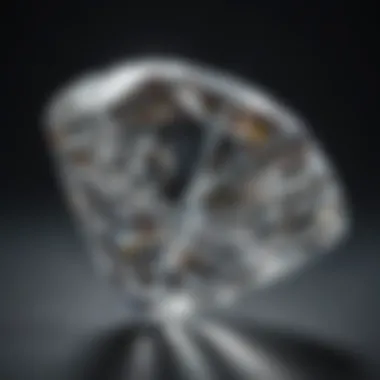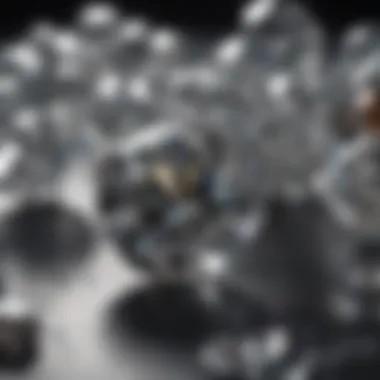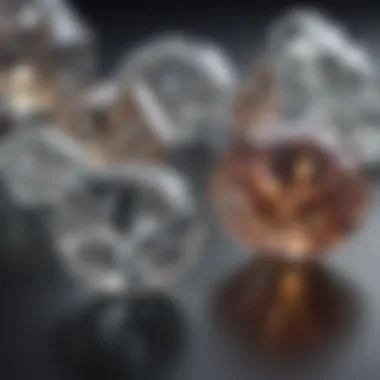Exploring Diamond Properties and Their Uses in Industry


Intro
Diamonds, often viewed as symbols of luxury and wealth, possess properties that extend far beyond their sparkling appearance. This article examines the unique characteristics of diamonds, exploring their intrinsic properties and diverse applications across multiple sectors. The aim is to provide a detailed understanding of why diamonds hold a revered position in our material world.
The multifaceted nature of diamonds brings them into numerous fields, such as jewelry making, industrial uses, and advanced technology. Moreover, as we unravel their significance, we will also delve into the historical context surrounding diamonds, the ethical dimensions of their procurement, and consider the implications of synthetic diamonds in today's market.
Key Points
- Intrinsic Properties of Diamonds: We will discuss hardness, thermal conductivity, and optical properties.
- Applications in Different Industries: Highlight how diamonds are utilized in jewelry, manufacturing, and technology.
- Historical Significance: Examine the journey of diamonds through history and their cultural impact.
- Ethical Considerations: Discuss the importance of ethical sourcing in the diamond industry.
- Future of Synthetic Diamonds: Explore emerging trends and technologies related to lab-grown diamonds.
By the end of this exploration, readers will gain a comprehensive perspective on diamonds, their functions, and the ongoing conversations that shape their future in both consumer markets and beyond.
Prologue to Diamonds
Diamonds are not only treasured as gemstones but also recognized for their unique properties that make them invaluable across various industries. In this section, we lay the groundwork for understanding the multifaceted nature of diamonds. This exploration is vital as it connects historical significance with modern applications.
Understanding diamonds begins with their rich history and the lasting impression they have made on cultures worldwide. The study of diamonds encompasses more than mere beauty; it involves appreciating their diverse uses in technology and industry. For individuals interested in geology and mineralogy, understanding diamonds deepens one’s comprehension of Earth’s formation and the geological conditions necessary for their creation.
The importance of the topic lies in its capacity to reveal how diamonds function in different roles. For collectors, recognizing the distinctions in diamond types, clarity, and cut can enhance collection efforts. Moreover, knowing the potential environmental and ethical implications in mining can inform collectors' choices, fostering a sense of responsibility in acquiring these precious stones.
Overall, the introduction to diamonds serves as a precursor to more detailed discussions about their chemical, physical, and optical properties, as well as their various uses in both jewelry and industry.
Historical Background
The history of diamonds is as complex as the stones themselves. Initially, diamonds were found in India, where they were regarded as symbols of love and power. Ancient texts reference their allure, hinting at their cultural significance dating back centuries. Their initial uses were not ornamental; diamonds were ground into powder for use in medicinal practices and armor construction.
By the Middle Ages, the fascination with diamonds had spread to Europe, where they became associated with nobility and wealth. They were often worn by royalty, and their presence signified status. This uptick in popularity prompted the skilled practice of diamond cutting, allowing for more refined shapes and enhanced brilliance.
Over time, the diamond trade expanded globally. The discovery of diamond deposits in Brazil and later, in South Africa, changed the landscape of both availability and pricing. Advances in mining and cutting techniques further democratized access, transitioning diamonds from exclusive status symbols to commodities.
Cultural Significance
Culturally, diamonds have been imbued with meaning that transcends their physical attributes. They symbolize eternal love in engagement rings, a tradition that solidified in the 20th century. The campaign by De Beers in the 1940s cemented diamonds as essential to romantic proposals, coining the phrase "A Diamond is Forever.” This spurred an increase in demand that fueled the diamond market further.
Different cultures attribute various meanings to diamonds. In some Eastern traditions, they are considered protective stones, believed to ward off evil. In the West, diamonds are seen as markers of commitment, luxury, and success.
Significantly, how diamonds are perceived collectively influences market trends and consumer behavior. Awareness of this cultural significance can both inspire collectors and impact their purchasing decisions.
Ultimately, the introduction to diamonds is foundational—it informs perceptions, guides ethics in acquisition, and highlights the cultural tapestry woven around these remarkable stones.
Fundamental Properties of Diamonds
Understanding the fundamental properties of diamonds is key to appreciating their diverse applications and significance. These properties define the behavior and characteristics of diamonds, contributing to their unique status across various industries, particularly in jewelry, technology, and industrial contexts. The intrinsic qualities of diamonds are not only remarkable but also lend themselves to a range of practical uses. This section discusses their chemical composition, physical properties, optical properties, and crystal structure.
Chemical Composition
Diamonds are composed primarily of carbon atoms arranged in a crystal lattice structure. Each carbon atom is bonded to four neighboring carbon atoms using strong covalent bonds. This unique arrangement provides diamonds with their exceptional hardness. The purity of the diamond affects its color and clarity, which are significant factors in determining value, particularly in jewelry. Variations in chemical composition can lead to colored diamonds, such as blue or pink, which arise from the presence of trace elements.
Physical Properties
Hardness
Hardness is a standout physical property of diamonds, rated at 10 on the Mohs scale. This makes diamonds the hardest naturally occurring substance known. Their exceptional hardness ensures they resist scratches and cuts, making them ideal for industrial uses like cutting tools. In jewelry, this quality enhances the durability of diamonds, ensuring they can withstand everyday wear. However, despite their hardness, diamonds can still be susceptible to chipping if struck with sufficient force in the wrong direction.
Density


Density is another vital physical property, with diamonds having a specific gravity of about 3.5. This characteristic influences the overall weight and feel of diamonds, particularly when set in jewelry. Although the density of diamonds can be advantageous for industrial applications, it may pose a challenge for certain types of engagement rings, where a more lightweight feel is often desired.
Thermal Conductivity
Diamonds exhibit exceptional thermal conductivity, rivaling some of the best conductors known. This property allows them to dissipate heat efficiently, making diamonds valuable in high-performance electronic applications, such as in heat sinks for semi-conductor devices. While thermal conductivity has advantages, it can also be detrimental in scenarios where heat retention is essential.
Optical Properties
The optical properties of diamonds significantly affect their value as gemstones and their applications in technology.
Refractive Index
Diamonds have a high refractive index of about 2.42, enabling them to bend light more than other materials. This quality contributes to their characteristic brilliance and fire, enhancing their appeal for jewelry. The capacity to refract light also finds applications in optics, wherein diamonds can serve as lenses or prisms for specific needs. However, the high refractive index may make diamonds less practical for some optical applications where clarity is paramount.
Dispersion
Dispersion refers to a material's ability to separate light into its constituent colors. Diamonds exhibit high dispersion, resulting in their ability to produce a spectrum of colors when light passes through them. This phenomenon adds to the visual allure of diamonds in jewelry settings. However, excessive dispersion may overshadow clarity, something that jewelers often navigate carefully.
Color Grading
Color grading is pivotal for evaluating diamonds in the jewelry market. Grading assesses diamonds on a scale ranging from completely colorless (D) to light yellow or brown (Z). The most valuable diamonds fall within the colorless to near-colorless range, as they reflect the most light and display the highest brilliance. This grading system governs pricing and desirability, impacting both consumer choice and market dynamics.
Crystal Structure
The crystal structure of diamonds is another fundamental property distinguishing them from other forms of carbon, such as graphite. Diamonds crystallize in a cubic lattice system, which is pivotal in imparting their hardness and optical brilliance. The unique arrangement of atoms ensures that energy is transmitted efficiently across the structure, allowing for their remarkable thermal properties. Understanding crystal structure is crucial for determining the diamond's performance in both jewelry and industrial applications.
Uses of Diamonds in Jewelry
Diamonds are often associated with luxury and elegance, playing a significant role in the jewelry market. This section explores the various aspects of diamonds as they relate to jewelry, including cuts, symbolism, and investment value. Each of these elements highlights the multifaceted nature of diamonds, underscoring why they are so highly valued. Understanding these characteristics helps to appreciate the diamonds not just as precious stones but as a deep-rooted part of cultural practices and investment strategies.
Diamond Cuts and Shapes
The cut of a diamond is crucial. It determines how well the stone reflects light, which contributes to its brilliance. Different cuts offer unique aesthetics and appeal, each carrying their own significances.
Round Cut
The round cut is the most popular diamond shape. It is designed to maximize brilliance and light dispersion, allowing for an exceptional sparkle. The round cut has a classic appeal, making it an ideal choice for engagement rings. Its ability to exhibit brilliance is unmatched, which is why many jewelers recommend this cut for first-time buyers. However, it also produces more waste during the cutting process, making it more expensive overall.
Princess Cut
The princess cut is another popular diamond shape, known for its modern square silhouette. This cut provides maximum brilliance and allows for larger appearances without sacrificing quality. Its unique shape and sharp lines cater to contemporary tastes, making it a preferred choice for those looking for a twist on the traditional round diamond. Though it is less brilliant than the round cut, the princess shape offers a unique blend of elegance and modernity.
Emerald Cut
The emerald cut is distinct with its large, flat facets. It offers a different kind of beauty by showcasing the clarity and color of the diamond rather than just its brilliance. This cut is often favored for its sophisticated look, particularly in vintage-style rings. However, because of its unique design, inclusions may be more visible, which can be considered a disadvantage. Still, it remains a strong choice for those who appreciate classic elegance.
Symbolism in Engagement Rings
Diamonds hold significant symbolism, especially in engagement rings. They represent enduring love and commitment. The tradition of using diamonds in engagement rings dates back to the 15th century when Archduke Maximilian of Austria gave a diamond ring to Mary of Burgundy. This practice has cemented the diamond's status as the ultimate symbol of love and devotion. Their rarity and beauty convey the message that true love is precious and should be celebrated.
Investment Value
Diamonds also hold investment potential. Many collectors view them not only as beautiful pieces but as assets. The value of diamonds can increase over time, especially rare ones with exceptional quality. Market trends play a crucial role in this aspect. Factors such as color, clarity, and carat weight influence the value of diamonds in the jewelry market. Investors often consider these aspects carefully when purchasing diamonds, as they combine both aesthetic pleasure and financial value.
Industrial Applications of Diamonds
The industrial applications of diamonds reveal a different dimension of this renowned gemstone, showcasing its significant role beyond aesthetics. Unlike their counterparts used in fine jewelry, industrial diamonds are crucial in sectors where durability and precision are paramount. Their unique properties facilitate a variety of tasks, making them indispensable in modern manufacturing and technology. This section examines some key areas where diamonds are applied, emphasizing their benefits and considerations.


Cutting and Grinding Tools
Diamonds are unparalleled when it comes to cutting and grinding tools. Their hardness makes them ideal for various machining applications. Industries rely on diamond-tipped blades and drill bits for efficient material removal and precision cutting. These tools can cut through tough materials like concrete, metals, and stone. The efficiency of diamond tools leads to reduced machining time and lower costs in the long run.
"The hardness of diamonds allows for extreme precision in cutting and grinding operations, which is unmatched by any other material."
Diamond grinding wheels are common in metalworking. They maintain their shape and sharpness much longer than traditional blades. This offers not only durability but also consistency in performance. As a result, manufacturers can achieve superior finishes on their products, reflecting the high standards necessary in today’s competitive market.
Mining and Oil Exploration
Diamonds also play a critical role in mining and oil exploration. Their hardness suits them well for drilling operations in tough geological formations. Various mining companies use diamond drill bits to ensure efficient penetration. These tools help in the extraction of essential resources, including minerals and petroleum.
The efficiency and effectiveness of diamond tools reduce the risks associated with drilling operations. The enhanced longevity of diamond bits warrants their initial higher cost, which is justified by the time and resources saved in operations. Consequently, industries continue to invest in diamond technology for their drilling needs.
Abrasives and Polishing Materials
In addition to cutting and drilling, diamonds are commonly used in abrasives and polishing materials. An assortment of industries employ diamonds for grinding, polishing, and finishing surfaces. In electronics, they help create micro-tools that shape components with precision. The familiar diamond paste is used increasingly in various polishing applications.
Polishing significantly improves the quality of finished products. This is essential in sectors producing high-value items, such as watches and fine optics. The ability of diamonds to achieve a mirror finish makes them a preferred choice across multiple domains.
The robust nature of diamond abrasives ensures longevity and efficiency in operations. They frequently outperform other materials, granting manufacturers a competitive edge by enhancing product quality and operational efficiency.
In summation, the industrial applications of diamonds illustrate their critical value across diverse fields. These powerful tools offer superior performance, drive efficiency, and are indispensable in various manufacturing and extraction processes. The ongoing investment in diamond technology indicates a promising future for their use in industries worldwide.
Technological Advances Involving Diamonds
The advancements in technology have significantly impacted the use of diamonds. Traditionally seen as precious gems, diamonds now hold a pivotal role in various technological applications, particularly in electronics and optical fields. Understanding these advances reveals how diamonds contribute to efficiency and innovation in multiple industries.
Electronics and Semiconductors
High-Power Electronics
High-power electronics utilize diamonds for their unique properties. Diamonds are known for their remarkable thermal conductivity and electrical insulation capabilities. This makes them suitable for managing heat in high-power applications, such as in power amplifiers and electric vehicles. The key characteristic of high-power electronics that makes diamonds advantageous is their ability to operate at higher temperatures compared to silicon-based devices. This resistance to heat helps improve reliability. However, the high cost of diamond materials can limit widespread adoption.
Quantum Computing
Quantum computing is another area where diamonds are making strides. One crucial feature of quantum computing is the quantum bits or qubits, which store information. Diamonds can host defects, known as nitrogen-vacancy centers, that enable the creation of stable qubits. This characteristic makes diamonds a popular choice for advancing quantum computing technologies. Despite this, challenges remain regarding scalability and integration with existing systems, which may slow down progress in this field.
Optical Applications
lasers
Lasers represent a significant application of diamonds, especially in industrial and medical fields. Diamond lasers can produce beams of light that are highly efficient and precise. The key feature of diamond lasers is their ability to operate at high powers while maintaining beam quality. They are beneficial for tasks such as cutting and welding materials. However, the complexity of manufacturing diamond lasers can make them less accessible for smaller operations.
Photonics
Photonics is another promising field where diamonds are present. Diamonds can be used to produce optical components that transmit light with minimal loss. A key characteristic of photonics applications is their ability to enhance data transmission speeds and reduce energy consumption. This makes diamond-based solutions an attractive option for improving communication technologies. The primary drawback is the higher production costs compared to conventional materials, which may hinder their adoption in some areas.
In summary, the technological advancements involving diamonds showcase their evolving role beyond luxury products. Their importance in electronics, quantum computing, lasers, and photonics points to a future where diamonds are central to innovative solutions in various industries.
Ethical Considerations in Diamond Mining
In recent decades, ethical considerations surrounding diamond mining have gained prominence. This section examines the implications of sourcing diamonds responsibly. The core issues include the potential for violence and exploitation, as well as initiatives aimed at ensuring sustainable practices in the diamond industry. Challenging the stigma associated with diamonds is crucial for consumers to make informed choices and to understand the full picture behind these gemstones.
Conflict Diamonds


Conflict diamonds, often referred to as "blood diamonds," are gems mined in war zones and sold to finance armed conflict against governments. This practice raises significant moral concerns. The sale of conflict diamonds has been linked to atrocities, affecting countless lives and perpetuating cycles of violence. The impact extends beyond immediate violence, leading to long-term socio-economic instability in affected regions.
Efforts such as the Kimberley Process Certification Scheme have been established to prevent the trade in conflict diamonds. This process requires that diamonds are certified as conflict-free before being sold internationally. However, its effectiveness has drawn criticism due to loopholes and insufficient enforcement mechanisms, allowing some conflict diamonds to slip through the cracks.
"The traceability of diamonds remains a concern. Without strict adherence to certification, the risk of purchasing a conflict diamond persists."
Awareness and education are vital in combating this issue. Consumers must demand transparency in the diamond supply chain. Jewelers should provide verifiable proof that their diamonds are sourced ethically. By choosing diamonds that are certified conflict-free, buyers can contribute to the stability and recovery of affected communities.
Sustainable Practices
Sustainable practices in diamond mining seek to mitigate environmental degradation and improve the lives of those involved in the mining process. The industry is slowly recognizing the need for environmentally friendly techniques and community engagement. Ethical sourcing also emphasizes fair labor practices, which can help foster better working conditions for miners.
Some diamond mining companies have initiated environmental restoration projects to reduce the impact of their operations. These efforts may include reforestation and rehabilitation of mined areas, showcasing a commitment to sustainability. Additionally, there is a growing trend toward supporting local communities through educational and health initiatives.
Here are a few key points about sustainable practices in diamond mining:
- Environmental Stewardship: Practices such as using less destructive mining techniques and reducing waste.
- Community Involvement: Engaging local populations in decision making regarding mining activities.
- Fair Trade Initiatives: Promoting ethical labor practices and fairness in the diamond trade.
By prioritizing these sustainable practices, the diamond industry can improve its overall image and foster a more responsible approach to mining. This benefits not only the environment but also ensures that mining positively impacts local communities. Consumers can play a role by supporting companies that commit to ethical and sustainable practices.
The Rise of Synthetic Diamonds
The trend toward synthetic diamonds is gaining momentum in today's world. This is primarily due to advancements in technology, along with a growing awareness of ethical concerns associated with natural diamond mining. The rise of synthetic diamonds allows for the production of gemstones that match or even exceed the quality of natural diamonds at a fraction of the cost. Understanding this transformation in the diamond market is crucial, especially for collectors and investors who wish to navigate the evolving landscape of diamond acquisition.
Methods of Synthesis
Process
The Chemical Vapor Deposition (CVD) process is a prominent method for producing synthetic diamonds. This technique involves creating a diamond in a controlled environment, using gases in a vacuum chamber. The gases decompose and deposit carbon onto a substrate, forming diamond crystals over time. The key characteristic of the CVD process is its ability to create diamonds with fewer impurities. This makes them particularly appealing for both jewelry and industrial use.
The unique feature of CVD diamonds is that they can be produced in various colors and sizes, allowing for customization that is not always possible with natural diamonds. Additionally, CVD diamonds are often less expensive, making them an attractive option for buyers seeking value. However, one drawback is that their production may take longer than other methods, leading to a potential supply delay in the market.
HPHT Method
High Pressure High Temperature (HPHT) is another widely used method to synthesize diamonds. This technique replicates the natural conditions found in the Earth's mantle, where diamonds are formed. HPHT diamonds are produced through subjecting carbon to extreme heat and pressure. The key aspect of the HPHT method is its ability to create large diamonds efficiently. This can result in relatively low prices for larger stones when compared to natural diamonds of similar size.
A distinct feature of HPHT diamonds is their resemblance to natural diamonds, often making it difficult to differentiate between the two without advanced testing methods. While HPHT diamonds have gained popularity for their size and cost, they can sometimes contain more inclusions than those produced by the CVD process, which may affect their clarity.
Market Implications
The rise of synthetic diamonds brings about significant implications for the market. As the production of synthetic diamonds becomes more widespread, the cost of natural diamonds may see downward pressure. This shift may lead collectors and investors to reassess the value of natural diamonds, considering factors such as rarity and ethical implications.
Additionally, the demand for ethically sourced products has never been higher. More consumers are becoming aware of the social and environmental impacts of diamond mining. Therefore, synthetic diamonds may find a favorable position in a market that increasingly values ethical considerations.
Comparative Analysis with Natural Diamonds
In comparing synthetic and natural diamonds, it is evident that both have their own sets of advantages and challenges. Natural diamonds are deemed timeless and often symbolize status and wealth. Conversely, synthetic diamonds offer advantages in cost and ethical sourcing.
- Cost Efficiency: Synthetic diamonds can be significantly cheaper than natural ones, making luxury more accessible to a wider audience.
- Environmental Impact: Production methods like CVD or HPHT often have a smaller ecological footprint compared to traditional mining methods.
- Availability: Synthetic diamonds can meet large demands more easily without the concerns tied to finite natural resources.
In summary, the rise of synthetic diamonds is reshaping perceptions in the diamond market. As both collectors and the general public navigate these changes, understanding the implications of this trend is essential for making informed choices.
Epilogue
The conclusion of this article encapsulates essential insights about diamonds, emphasizing their significance across various domains. Understanding the myriad of properties diamonds possess allows readers to appreciate their value beyond just aesthetics.
Future of Diamonds
The future of diamonds is poised for interesting developments due to advancing technology and changing societal values. Synthetic diamonds, produced through methods like Chemical Vapor Deposition and High Pressure High Temperature, are gaining recognition. They offer similar characteristics as natural diamonds while presenting potential for lower costs and reduced environmental impact. The market for these synthetic alternatives is expanding, catering to a growing demand for ethically sourced materials. Moreover, innovations in diamond applications, particularly within technology and industry, suggest that their role will only deepen.
Final Thoughts
In summary, diamonds are not merely luxury items; they embody a fusion of beauty and utility. From their historical significance to contemporary concerns about ethical sourcing, understanding diamonds' properties can enhance appreciation for this remarkable material. For collectors and enthusiasts, staying informed about both natural and synthetic diamonds is vital for making informed decisions. Their journey from formation in extreme conditions to becoming a sought-after resource illustrates the complexities involved in their existence and allure.







